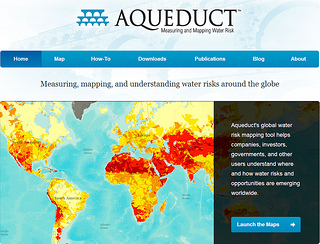As climate change changes the availability of water, companies need to understand how unprecedented floods and droughts will affect their business and communities.
Based on high resolution data, the Aqueduct Water Risk Atlas does just that.
"Recent history is littered with companies that failed to anticipate emerging threats," says Andrew Steer, president of World Resources Institute, which developed the maps. "Thankfully, forward-thinking businesses are starting to get it. They understand that water risk is one of the top issues that they face. This new platform will provide companies with comprehensive, high-resolution tools to measure water risk."
The Atlas is a customizable global map, based on 12 indicators of physical, regulatory, and reputational risk. In a user-friendly way, companies can evaluate how water stress, flood occurrence, access to water, drought, and other issues may affect operations. It can be tailored specifically for nine water-intense industry sectors – from oil and gas, to agriculture, to chemicals.
Users can plot the locations that matter most to them – from facilities, to suppliers, to potential new markets or proposed power plants – and compare those locations’ potential exposure to water stress and risk. They can also review maps of individual indicators, such as seasonal variability, which are important to operations.

To develop the resource, World Resources Institute worked with founding members of the Aqueduct Alliance, General Electric and Goldman Sachs, as well as the Skoll Global Threats Fund, Shell, Bloomberg, Talisman Energy, Dow, United Technologies, DuPont, John Deere, Veolia Water, and the Dutch and Swedish governments.
"Water is an incredibly important part of both the manufacture and use of P&G brands," says Len Sauers, vice president of global sustainability for Procter & Gamble. "We want to make sure all of our operations are in locations that are best for both our business and the environment, so partnering to understand water scarcity and related issues throughout the world is critical. Our partnership with WRI and their Aqueduct technology helps us screen for potential water risks, ensuring we are in the best place possible to both grow our business and help steward the world’s resources."
Companies have been using earlier versions to understand how their operations and supply chains may be exposed to water risk. McDonald’s, for example, asked 353 global suppliers to run local water risk assessments on their facilities.
Procter & Gamble, Owens-Corning, and AU Optronics have used it to understand how local water supply, quality, and other risk factors may affect their global facilities, and to prioritize water efficiency and other investments.
Take a look at the mapping tool:
